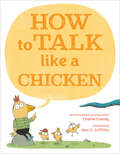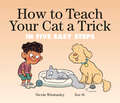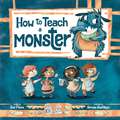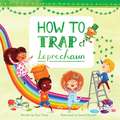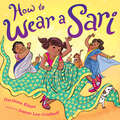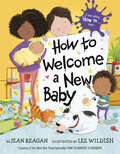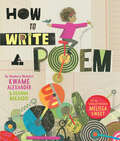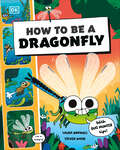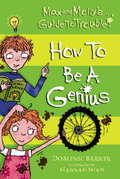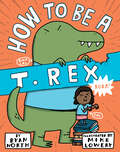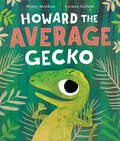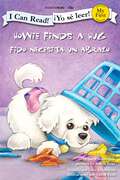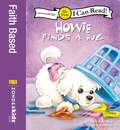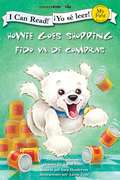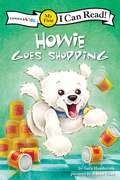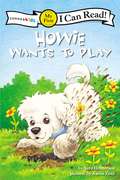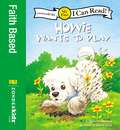- Table View
- List View
How to Talk Like a Chicken
by Charlie GrandyFrom the duo behind How to Talk Like a Bear comes a hilarious new picture book!You may think talking like a chicken is all clucking and bawking and flapping your arms, but it's actually far more complicated than that. Like all languages, it has many intricacies. For example, chickens also peep and ruffle their feathers. Very complex.Told in the same fourth-wall-breaking style of How to Talk Like a Bear, a hilarious little chicken guides the reader through important phrases and situations so that all readers are prepared to wow their family members and various farm animals with their perfect chicken prose. It may even come in handy in the off chance a peaceful farm is threatened by a menacing fox!How to Talk Like a Chicken is a perfect read-aloud and a great gift for any child looking to expand their worldview into the vast culture of the Chicken language.
How to Talk Monster
by Lynn PlourdeA whimsical and giggle-inducing exploration of what might happen when a monster visits at bedtime from award-winning children's author Lynn Plourde and the playful imagination of #1 NYT bestselling illustrator, Mike Lowery.A Little Boy is just trying to go to sleep when a Little Monster creeps up to his window and . . . says goop-zee-googy! Or, peek-a-boo!, in case you don't speak Monster. Hilarity ensues as the Little Monster tries to play with the Little Boy despite the language barrier. While at first scared, the Little Boy comes to Little Monster's rescue when he gets hurt and the two new friends are able to play together all night long.Complete with a glossary translating the monster language used throughout, this classic nighttime adventure story will have little readers wishing for a Little Monster to knock on their window at night.
How to Talk to Your Computer (Let's-Read-and-Find-Out Science 2)
by Seymour SimonRead and find out about the basics of computer language in this colorfully illustrated nonfiction picture book.Have you ever wondered how to get a computer to do something? First you need to speak in a way it can understand! Read and find out all about how to talk to your computer in this updated edition with new illustrations and simple engaging text that introduces conditions, loops, and functions.How to Talk to Your Computer comes packed with visual aids like charts, sidebars, an infographic, and a computer-less coding activity. This updated 2019 edition was vetted by Dr. Justin Solomon, Assistant Professor at Massachusetts Institute of Technology.This is a clear and appealing science book for early elementary age kids, both at home and in the classroom. It's a Level 2 Let's-Read-and-Find-Out, which means the book explores more challenging concepts for children in the primary grades. The 100+ titles in this leading nonfiction series are:hands-on and visualacclaimed and trustedgreat for classroomsTop 10 reasons to love LRFOs:Entertain and educate at the same timeHave appealing, child-centered topicsDevelopmentally appropriate for emerging readersFocused; answering questions instead of using survey approachEmploy engaging picture book quality illustrationsUse simple charts and graphics to improve visual literacy skillsFeature hands-on activities to engage young scientistsMeet national science education standardsWritten/illustrated by award-winning authors/illustrators & vetted by an expert in the fieldOver 130 titles in print, meeting a wide range of kids' scientific interestsBooks in this series support the Common Core Learning Standards, Next Generation Science Standards, and the Science, Technology, Engineering, and Math (STEM) standards. Let's-Read-and-Find-Out is the winner of the American Association for the Advancement of Science/Subaru Science Books & Films Prize for Outstanding Science Series.
How to Teach Your Cat a Trick: in Five Easy Steps (How to Cat books)
by Nicola WinstanleyIn this hilarious and clever follow-up to How to Give Your Cat a Bath, a boy, a dog and a know-it-all narrator are thwarted by a cat who refuses to learn a trick. The perfect read-aloud for fans of Interrupting Chicken.Step one: Decide on a trickStep two: Get some treats readyStep three: Hold the treat in your hand and ask your cat to do the trickStep four: Watch your cat do exactly what you asked him to doStep five: Reward your cat for doing the trick Simple, right? This spoof on an instruction manual features an increasingly bewildered human, a nonchalant cat, a very good dog and a know-it-all narrator . . . who really doesn't know it all. How DO you teach a cat a trick? Read on to find out!
How to Teach a Monster (Magical Creatures and Crafts)
by Sue FliessWhat happens when a big furry monster no longer wants to be scary? How can he figure out what his other talents are? In this installation of Sue Fliess and Simona Sanfilippo's Magical Creatures and Crafts series, an unhappy monster is hoping to get out of the scaring business. But it's all he's ever known. So one day he realizes the key lies in learning a new skill. And who better to teach him something new than a group of kind and patient kids? The kids agree to help him and offer to teach him a number of things—and he chooses baking a cake. The story follows the monster as he learns how to bake and decorate. The journey includes funny monsterly snafus, but in the end he makes a monster of a cake and is proud to have learned and changed. Kids will delight in the monster's trials and errors, and cheer him on when he persists and finds success. Fliess&’s bouncy read-aloud rhyming text and Sanfilippo&’s energetic, whimsical illustrations will bring joy to young readers as they watch the children exercise patience with a monster who is just a little bit self-conscious and clumsy. Also included are guides for teachers and parents about popular monsters in stories and media, as well as instructions for making a monstrously fun and delicious cake!
How to Train a Tooth Fairy (Magical Creatures and Crafts #9)
by Sue FliessWhat happens when you have a loose tooth, but it's the Tooth Fairy's first day on the job? How will she find you and where will she leave her gifts? In this installation of Sue Fliess and Simona Sanfilippo's Magical Creatures and Crafts series, a group of children wonder what happens if the Tooth Fairy assigned to collect their most recent lost tooth is brand new to her job. How will she know where to find the tooth? What if she goes to the wrong room? To help the Tooth Fairy remember her training, the children devise a plan that will guarantee her success! With the right supplies—colored paper, crayons or pens, scissors, stickers and glitter, and ribbon—young readers who have a wiggly tooth or have recently lost a baby tooth can also help train their Tooth Fairy by making a sign for their bedroom doors similar to the ones the children make in the book. Fliess&’s bouncy read-aloud rhyming text and Sanfilippo&’s energetic, whimsical illustrations will bring joy to young readers as they watch the children create a scene that will direct the little Tooth Fairy to the tooth she seeks. Also included are guides for teachers and parents about the origin and history of the Tooth Fairy, as well as instructions for making the craft featured in the book.
How to Trap a Leprechaun
by Sue Fliess Emma RandallLegend has it that if you catch a leprechaun, he’ll grant you a wish. But, be careful! Leprechauns are full of trickery. To catch one, you’ll need to be clever in crafting your trap. Grab some glitter and glue and get prepared for your wily holiday visitors! <P><P>On the night before St. Patrick’s Day, leprechauns show up to steal your treasures and then disappear as quickly as they came. However, if you’re careful you might be able to catch one and then he’ll grant you a wish. You’ll have to be sneaky and set just the right trap to trap a leprechaun. <P><P>Sue Fliess’s read-aloud text and Emma Randall’s whimsical illustrations will provide much fun for young readers eager to catch their very own leprechaun! But beware: leprechauns may leave you with nothing but a cardboard box and a shoe or two.
How to Trick a Christmas Elf (Magical Creatures and Crafts #3)
by Sue FliessTo find out whether Santa thinks you&’re naughty or nice, you&’ll need to trick an elf into letting you see the list! Legend has it that the only way to find out if you&’re on Santa&’s naughty or nice list is to trick an elf into letting you sneak a peek! But be careful: elves are tricky themselves! To get a look at the list, you&’ll need to be clever in crafting a distracting craft to catch the elf&’s attention. So, grab some Christmas supplies like ribbons, twinkle lights, bows, and candy canes, and get prepared for your sly holiday visitor! On the nights leading up to Christmas, one of Santa&’s elves will show up to keep watch on kids and to report on their naughty or nice behavior! However, if you&’re careful and clever and quick, you can set up a beautiful little sleigh that will distract your elf, and then you&’ll be sure to get a glimpse at Santa&’s list! Sue Fliess&’s poetic read-aloud text and Simona Sanfilippo&’s vibrant, whimsical illustrations will provide much fun for young readers eager to trick their own Christmas elf and find which list they&’re on! Also included are guides for teachers and parents about how to engage children in building an elf sleigh themselves and how to interest them in the history of the holiday and the many cultures that celebrate Santa&’s tiny helpers.
How to Wear a Sari
by Darshana KhianiSparkling with voice and charm, this picture book about a fashionable kid out to prove she&’s not as small as everyone thinks is perfect for kids eager to grow up, and for those who love to play dress-up.Being a little kid isn&’t always fun and games. Sometimes, it&’s downright annoying. When a little girl tires of being treated like she&’s TOO little, she sets out to prove to her family that she can do ANYTHING she puts her mind to . . . . . . including putting on a colorful, twinkly, silky sari. Sure, they&’re long and unwieldy—but that only means her family will be even more impressed when she puts it on all by herself. Naturally, there are some hiccups along the way, but she discovers that she&’s not the only one in her family who has set out with something to prove, with hilariously chaotic results. That&’s what photo albums are for!
How to Welcome a New Baby (How To Series)
by Jean ReaganFrom the New York Times bestselling creators of How to Babysit a Grandma and How to Babysit a Grandpa comes a fun and adorable picture book about how to welcome a new baby into your family!A new baby is coming! Do you know what to do? This heartwarming new addition to the bestselling How to... series is all about welcoming a new sibling into your family. Learn how to get ready for the baby, how to make the baby laugh, and how to help Mom and Dad when things get a little topsy-turvy. Follow along through the first year of baby's life, and learn How To... from the experts -- kids! Filled with charming role-reversal humor, creative ideas, and sweet moments, How To Welcome a New Baby is sure to delight new siblings and growing families everywhere!
How to Write a Poem
by Kwame Alexander Deanna NikaidoIn this evocative and playful companion to their New York Times bestselling picture book How to Read a Book, Newbery Medalist Kwame Alexander teams up with poet Deanna Nikaido and Caldecott Honoree Melissa Sweet to celebrate the magic of discovering your very own poetry in the world around you. <P><P> Begin <P> with a question <P> like an acorn <P> waiting for spring. <P><P> From this first stanza, readers are invited to pay attention—and to see that paying attention itself is poetry. Kwame Alexander and Deanna Nikaido’s playful text and Melissa Sweet’s dynamic, inventive artwork are paired together to encourage readers to listen, feel, and discover the words that dance in the world around them—poems just waiting to be written down. <P><P><i>Advisory: Bookshare has learned that this book offers only partial accessibility. We have kept it in the collection because it is useful for some of our members. Benetech is actively working on projects to improve accessibility issues such as these.</i>
How to Write a Story
by Kate MessnerHelp your child explore their creativity with this ten-step guide to writing a story. Step 1: Choose an idea for your story. A good one. Step 2: Decide on a setting. Don&’t be afraid to mix things up. Step 3: Create a heroine—or a hero. Now: Begin. Accomplished storytellers Kate Messner and Mark Siegel playfully chronicle the process of becoming a writer in this fun follow-up to How to Read a Story, guiding young storytellers through the joys and challenges of the writing process. From choosing an idea, to creating a problem for their character to resolve, to coming to The End, this empowering picture book breaks down the writing process in a dynamic and accessible way, encouraging kids to explore their own creativity—and share their stories with others! Praise for How to Write a Story&“That muse of fire isn&’t going to ascend all by herself, so Messner and Siegel, in their follow-up to How to Read a Story, walk readers through 10 steps of literary creation, starting with &‘search for an idea&’ and ending with &‘share your story&’. . . . Readers new to writing should find this accessible volume a smart choice to get the creative writing juices flowing.&” —Publishers Weekly&“A lovely encouragement to young writers to persist.&” —Kirkus Reviews
How to Write a Story: (read-aloud Book, Learn To Read And Write)
by Kate MessnerHelp your child explore their creativity with this ten-step guide to writing a story. Step 1: Choose an idea for your story. A good one. Step 2: Decide on a setting. Don&’t be afraid to mix things up. Step 3: Create a heroine—or a hero. Now: Begin. Accomplished storytellers Kate Messner and Mark Siegel playfully chronicle the process of becoming a writer in this fun follow-up to How to Read a Story, guiding young storytellers through the joys and challenges of the writing process. From choosing an idea, to creating a problem for their character to resolve, to coming to The End, this empowering picture book breaks down the writing process in a dynamic and accessible way, encouraging kids to explore their own creativity—and share their stories with others! Praise for How to Write a Story&“That muse of fire isn&’t going to ascend all by herself, so Messner and Siegel, in their follow-up to How to Read a Story, walk readers through 10 steps of literary creation, starting with &‘search for an idea&’ and ending with &‘share your story&’. . . . Readers new to writing should find this accessible volume a smart choice to get the creative writing juices flowing.&” —Publishers Weekly&“A lovely encouragement to young writers to persist.&” —Kirkus Reviews
How to be a Dragonfly (in association with the Royal Entomological Society)
by DKShrink to the size of a garden bug and enter the world of dragonflies in this first graphic novel for children.This graphic novel of garden life, made in collaboration with the Royal Entomological Society, is a perfect introduction to dragonflies for bug-obsessed little ones aged 5-7.Follow a newly hatched dragonfly as he learns to navigate pond life and meet plenty of fascinating bug characters along the way, in this first graphic novel. Narrated by a wise old grasshopper, offering tips and tricks on how to be a dragonfly and featuring laugh-out-loud moments, this tale of pond life is a perfect introduction to dragonflies for bug-obsessed kids.This bug book for children offers: A graphic novel format to engage children in nonfiction topics.Content made in partnership with the Royal Entomological Society, providing scientific information about insects.An engaging story about a newly hatched dragonfly as he learns how to navigate pond life.Chase thinks he'll stay a nymph forever. And it's not a bad life, in the pond he calls home. He's mastered the art of jet propulsion, how many insects can say that? But still, it would be quite fun to be one of those big, shining blue and green dragonflies flying overhead, chasing one another and making daring escapes from birds. Learn all about his exciting life in How to be a Dragonfly.More in the seriesLearn all about insects through a fun and engaging graphic novel format in this series made in collaboration with the Royal Entomological Society. If you enjoyed How to be a Dragonfly, why not follow the life of a ladybug with How to be a Ladybug?
How to be a Genius
by Hannah Shaw Dominic BarkerIn this Guide to Trouble, Max and Molly will show you, clever reader:1. How to mend a puncture WITH MUD2. How to cover Mr Everett's dog WITH MUD3. How to accidentally-also-at-the-same-time be a real-life GENIUS!
How to be a T. Rex
by Ryan NorthAn upROARiously funny take on following your wildest dreams, from the bestselling creator of Dinosaur ComicsBeing a regular old human is kind of a drag. That's why Sal is not going to be a teacher or doctor or lawyer when she grows up. She is going to grow up to be an awesome Tyrannosaurus Rex. Her brother thinks it's impossible, but Sal sure shows him! And in the beginning, being a T. Rex is AWESOME. But did you know that it's kind of hard to make friends when you are a super-giant, super-loud, super-stompy dinosaur? If only there were a way for Sal to be 100% awesome, 100% of the time...Eisner Award-winning writer Ryan North makes his picture book debut with this bright, bold, and quirky story about finding--and taming--the beast within.
Howard B. Wigglebottom Learns to Listen
by Howard Binkow Susan F. CornelisonFor ages 4-7. Imagine how much easier life would be if children listened better. Meet Howard B Wigglebottom, a curious rabbit who just doesn't listen! This new illustrated book, has been created to help children improve their listening skills and pay attention. Educators, parents, and children alike will laugh and learn as Howard B Wigglebottom learns to listen.
Howard the Average Gecko
by Wendy MeddourSome of the world's most amazing animals are camouflaged! Too bad Howard is too full of himself to notice.Howard thinks he's the most exceptional creature in the entire rainforest. That's because no other creature is as fantastically camouflaged as he is! But when Howard learns that other creatures can be camouflaged, too, he doesn&’t feel so special anymore. In fact, he might just be...GASP...average! Who could ever love a completely unexceptional gecko like Howard? Dip into this vibrantly illustrated and funny tale to find out!
Howie Finds a Hug / Fido recibe un abrazo (I Can Read! #My First Shared Reading)
by Sara HendersonIn Howie Finds a Hug, readers learn that «a family is a hug from God» Young children will identify with Howie, an adorable puppy who needs some attention. Winsome illustrations and easy text make this a great choice for early readers. En Chispa recibe un abrazo los lectores aprenden que «una familia es un abrazo de Dios». Los niños pequeños se identificarán con Chispa, un adorable cachorro que necesita atención. Las ilustraciones atractivas y el texto fácil hacen de este libro una gran selección para los primeros lectores.
Howie Finds a Hug: My First (I Can Read! #My First Shared Reading)
by Sara HendersonIn Howie Finds a Hug, readers learn that “a family is a hug from God.” Young children will identify with Howie, an adorable puppy who needs some attention. Winsome illustrations and easy text make this a great choice for early readers.
Howie Goes Shopping / Howie va de Compras (I Can Read! #My First Shared Reading)
by Sara HendersonHowie likes to shop. But, oh my! What a mess he makes. Apples drop. Balloons pop. Emma cries, "Stop!" Oh, no! Is Howie in trouble? Howie quiere hacer de compras. ¡Pero, ah mi! Lo que un lío él hace. Las manzanas dejan caer. Los globos pinchan. ¡Los gritos de Emma, la "Parada"! ¡Ah, no! ¿Está en un apuro Howie?
Howie Goes Shopping/Fido va de compras (I Can Read! #My First Shared Reading)
by Sara HendersonHowie’s shopping spree gets out of hand, and trouble abounds. Early readers will learn that no matter how bad things get, families stick together and love each other. Howie Goes Shopping will keep My First–level readers turning the pages to find out what happens next. La salida para ir de compras de Chispa se ha descontrolado, y los problemas abundan. Los primeros lectores aprenderán que sin que importe lo malas que estén las cosas, las familias permanecen unidas y se quieren los unos a los otros. Chispa va de compras mantendrá a sus lectores de primer nivel volteando páginas para saber lo que sucede luego.
Howie Goes Shopping: My First (I Can Read! #My First Guided Reading)
by Sara HendersonHowie’s shopping spree gets out of hand, and trouble abounds. Early readers will learn that no matter how bad things get, families stick together and love each other. Howie Goes Shopping will keep My First–level readers turning the pages to find out what happens next.
Howie Wants to Play / Fido quiere jugar (I Can Read! #My First Shared Reading)
by Sara HendersonIn Howie Wants to Play beginning readers learn that God loves them no matter what. It’s a lesson playful Howie learns after he makes some big messes. The fun illustrations match the tone of the story. My First-level readers will find this book to be as irresistible as Howie himself. En Chispa quiere jugar los lectores principiantes aprenden que Dios los ama pase lo que pase. Esta es una lección que Chispa aprende después que hace sus buenas trastadas. Las divertidas ilustraciones se corresponden con el tono del relato. Los lectores de nivel 1 hallarán a este libro tan irresistible como el mismo Chispa.
Howie Wants to Play: My First (I Can Read! #My First Guided Reading)
by Sara HendersonIn Howie Wants to Play beginning readers learn that God loves them no matter what. It’s a lesson playful Howie learns after he makes some big messes. The fun illustrations match the tone of the story. My First-level readers will find this book to be as irresistible as Howie himself.
